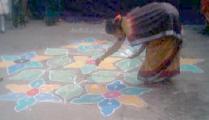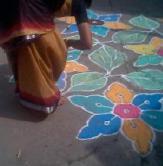|
 |
|

The ghazal
(pronounced somewhat like the English 'guzzle'),
derived from the Persian qasida,
accompanied the Moghuls as they began conquering
northern India in the twelfth century. From
Persian the preferred language of the ghazal
became Urdu. Initially its greatest following was
in the south. However, after the great court poet
Wali Deccany visited Delhi in
1700 its popularity and evolution across India
gathered momentum.- The ghazal is a
poetic form comprising a collection of shers,
independent two-lined poems. Thus each couplet,
or sher, is a virtually
autonomous expression of ideas. However a
collection of sher does not necessarily
constitute a ghazal.
- A ghazal is always
introduced with a matla, a mono-rhyming
couplet (sher) whose pattern is
repeated in the closing line of each successive
couplet. This couplet was considered in Persian
as a single line interrupted by a long pause.
This mono-rhyming convention, qafia,
demands that two or three words at the end of the
first line rhyme with their counterpart in the
second line of the opening and all couplets
thereafter. So the second line of all the shers
must conclude with the same word or words.
|
Structure
of the Ghazal
|
- The opening couplet
of the ghazal establishes its
ambience while the closing couplet, makta,
has a more personal character. Beher
is each sher's metric 'length'
or scan and both couplet lines should have
identical beher. Modern ghazals
may be written in virtually any language. (These
notes summarise more detailed information
accessible through the websites listed at the
conclusion of this page.)
|
Agha Shahid Ali
|
The late and wonderful
Indian poet Agha Shahid Ali lived in the
United States of America and wrote his ghazal in English. Here are some
separate examples of his sher |

- Rangoli
(Kolam)
|
- I say That,
after all, is the trick of it all
- When
suddenly you say "Arabic of it all."
..
-
- For Shahid
too the night went quickly as it came.
- After that,
O Friend, came the music of it all.
|
- What will
suffice for a true love knot? Even the
rain?
- But he has
bought grief's lottery, bought even the
rain. ..
-
- They've
found the knife that killed you, but
whose prints are these?
- No one has
such small hands, Shahid, not even the
rain.
|
|
 |
- Suspended in the
garden, Time, bit by bit, shines
- As you lean over
this page, late and alone, it shines. ..
-
- Mark how Shahid
returns your very words to you.
- It's when the heart,
still unbriefed, but briefly literature, shines.
|
'Ghazal' in
class


|
- A suggested
procedure for introducing 'ghazal' form to
students:
* Find a three or four word cliché or phrase
* Now 'tack' it on the end of a poetic line
* Use the original phrase to conclude a
thematically related second line that scans
identically
* Read your couplet to others
* Or feed these back to the whole group
* For the second part of this exercise you may
maintain the theme or focus of your original
couplet
* Consider the original phrase. You might
consider developing a new phrase that maintains
the overall word-rhyming pattern of the first.
However traditional 'ghazals' are 'mono-rhyming'
and it is necessary only to maintain the mono-rhyming
original phrase.
* Now use this new phrase to conclude line one of
a new couplet
* Use the original phrase to conclude the second
line of this new couplet
* Share both couplets. They need not be
philosophically sequential in intention
* Each couplet is an independent self-contained
poem. However a theme may run through evolving
couplets. Typically there will be between five
and fifteen couplets
* Embed your name explicitly or cryptically in
the closing couplet (eg in 'riddle' form - As 'Bob',
mine might be 'robot (for 'Robert''!) as in the
ghazal I've attempted below. My 'ghazal' takes a
liberty with the rhyming phrases concluding the
first line of each couplet. In fact it is not a
requirement of true 'ghazals' that the first line
rhyme with the second!
|
Setting
ghazals to music
|
- Ghazals are
probably as popular in their 'sung' form as they
are presented as poetry. Considering the relative
simplicity of the ghazal structure teachers who
have skills as musicians might enjoy working with
their students to set original 'ghazal' shers
to music.
|
Helpful Web-links
|
- For greater detail
try these sites: Ghazals by Agha Shahid Ali (Poetry
Net)
Urdu Ghazal : An introduction: http://www.msci.memphis.edu/~ramamurt/ghazal.html
A Nazm A Month: http://www.urdustan.com/anam/
Jagjit & Chitra Singh http://www.trill-home.com/jc/
More Ghazals by Mirza Ghalib http://www.cs.wisc.edu/~navin/india/songs/ghalibindex.html
Malaysian Ghazal http://www.music.upm.edu.my/ghazalmalay.html
|



